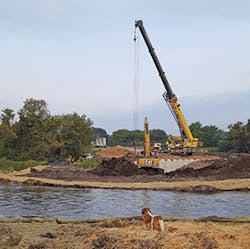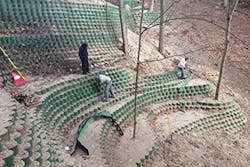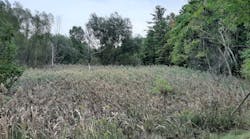As employment laws shortened the workday toward the end of the 19th century, the concept of “leisure time” arose. Spending time away from factories or offices to enjoy the outdoors, particularly the newly created systems of parks, gardens, trails, and green spaces—many designed by landscape architect Frederick Law Olmsted—was advanced as a healthy pursuit for city dwellers. At around the same time, religious leaders founded the Chautauqua Institution in the remote and geographically beautiful regions of upstate New York, adopting the name of the nearby lake for their organization. Originally created for people to engage in intensive religious study and contemplation, the mission quickly expanded to include music, arts, cultural program offerings, and a forum to discuss relevant current issues and ethical questions.
The term Chautauqua (a word from the Iroquois meaning “bag tied in the middle” or “two moccasins tied together,” which roughly describes the shape of the New York lake) became synonymous with retreat, and it was widely borrowed by other similar-minded groups dedicated to healthful outdoor recreation. This movement was the inspiration of one George Grey, a Chicago philanthropist, who in 1890 began a summer recreation venue for inner-city children and their mothers, located on the breathtaking shores of Lake Michigan. With dunes, water, wildlife, and fresh air, the Saugatuck Harbor camp enjoyed a long run as a retreat for its residents and visitors. The site included recreation and dining halls, cabins, and tent areas.
Today, the 130-acre property is being redeveloped into a community known as Dunegrass, with single-family homes being built on the site. Although it has changed little over the last century, development requires several modifications and poses engineering challenges.
“This is a pristine natural environment with white sand beaches, dunes, and native vegetation,” says Scott Czewski, midwest regional manager for Strata Systems Inc. “The developers were very clear that any amendments to this historic church retreat property had to be done, first, with minimal disturbance to the natural landscape, and, second, with materials that were both functional and had low visual impact. In other words, mitigate erosion, support native vegetation, and maintain a highly aesthetic appearance.”
Strata Systems provides textile-based geosynthetic solutions for soil reinforcement. The company was acquired in 2007 by Glen Raven Inc., the textile manufacturer that invented pantyhose, revolutionized outdoor fabric markets with its Sunbrella fabric, and provided the material for the American flag planted on the moon in 1969. “Strata Systems provided Glen Raven the gateway into the construction materials market with its broad range of erosion and soil management solutions,” says Czewski.
In addition to a range of geosynthetic fabrics, the company also offers StrataPro software, which allows engineers and contractors to design and visualize a project by creating images based on client inputs. The software can calculate material quantities needed for face area, reinforcement, infill, and drainage—all critical factors in planning and to forecast costs, labor needs, and project timelines.
For the Saugatuck property, Strata’s technical assistance services partnered with a local geotextile specialist, Mark Cavanaugh of Hanes Geo Components in Grand Rapids, MI. Hanes Geo Components manufactures TerraCell cellular confinement system, which is used for slope stabilization and can be layered to construct retaining walls.
The project involved the complex task of reinforcing a steep slope to accommodate roadway widening; the roads would need to support heavy vehicles such as construction equipment and, eventually, emergency vehicles like fire trucks that might enter the development. Yet the old roads were in the middle of the woods, and in building the retaining walls necessary to support the expanded roadway, the developers also wanted to maintain the landscape’s integrity.
“The open face of the TerraCell wall system captures rainwater, reducing erosion problems in the steep areas of our site,” explains Cavanaugh. Strata Systems manufactures the StrataGrid used for wall reinforcement.
“The product comes in 6- by 300-foot rolls, and it doesn’t have memory, so when it’s unrolled it lies flat and you can cut it to your size,” says Czewski. “You start at the bottom of your slope, you cut it to the length you need, and the geogrid extends back into the slope laterally the required distance. Then you build your wall vertically in a terraced pattern, which is what we did in the Lake Michigan project.”
Cavanaugh says that the Michigan project began in October of 2016 and finished in December of that year, with about 9,750 square feet of retaining wall installed.
“The customer was very pleased that we had minimal intervention and low impact to the environment during the process. It was not only visually pleasing but in compliance with regulatory oversight to accommodate stormwater runoff.”
Sandi Groenendal of Serenity Gardens Landscaping, who was responsible for planting the Dunegrass TerraCell wall, says, “The open pockets in the face allowed us to plant the correct species to create a backdrop matching the unique environment of the site conditions.”
“The developers now have good, safe access to the property, the environment is well protected from erosion, and the TerraCell product with its HS-20 loading support will sustain the weight of 20,000-pound trucks that will be used as the building and development project goes forward,” says Cavanaugh.
Sealing in the Seeds
The name Weyerhaeuser is a staple in the wood industry, and Jim Sandherr, national sales manager for Mat Inc. of Floodwood, MN, explains the link between the two entities and how erosion control products evolved from the lumber giant.
“In the mid-1980s, Weyerhaeuser was getting into the wood mulch business and they began using sub-manufacturers to expand their production capabilities with different product lines. Mat Inc. was one of these subs, and the Weyerhaeuser research team developed a unique soil erosion product using wood fibers.
“Their scientific team came up with a product that uses our proprietary ingredients mixed with a natural, plant-based product called guar gum, which is a polysaccharide, a big name for a starchy, high-sugar molecule material, to be mixed in with the wood fibers. This formulation then was the genesis of our flagship product SoilGuard, a bonded fiber matrix, or BFM.”
Often seen in the ingredient list on food packaging, guar is not a mystery food but is, in fact, a drought-resistant plant in the pea family whose seeds, when ground to a fine powder, are used throughout many industries. Commonly used as a thickening agent for foods like sauces and ice creams, it is also a popular binder and thickener for industrial and commercial uses, and is particularly beneficial as a hydromulch agent.
“Adding the guar gum creates a viscous product that makes application easy, as the wood fibers become more uniformly suspended for application. When it’s mixed with other agents and sprayed out, a matrix is formed as the wood fibers dry. It acts as a coating that adheres especially well to soil, so when fertilizer and seeds are part of the mix, everything stays put and grows uniformly across the slope area.”
Vicky Dosdall, CPESC, owner of Lawn and Driveway Service Inc. in Morris, MN, is both a user and, more recently, a distributor of Mat Inc. soil management products. Her company provides erosion control services throughout the upper Midwest.
“Over the last three decades, our company has evolved away from the residential arena to now doing primarily highway work, focusing on large 10- to 200-acre seeding and erosion jobs for federal and state or county roadway properties. However, we not only had to change our equipment capacity but also acknowledged the benefit in supplying erosion management products such as erosion control blankets, silt fences, geotextile materials, and more to our project clients, and also to the local markets. Lawn and Driveway Service has now evolved to being a supplier and only doing some small local private projects.
“Typically, there are few resources in this rural area; people may have to drive 90 to 150 miles or more to get what they need for hydroseeding, erosion control, and so forth. As a distributor, we can tell people how well the products work as we use them here, and we’re seeing brand loyalty to them because they do work,” affirms Dosdall.
She says that the state department of transportation, MNDOT, has specifications for roadway stabilization and vegetation. “The Mat Inc. line fits well with their specs for all of their categories.”
Retaining wall at the Dunegrass development on Lake Michigan
SoilGuard has an almost-30-year track record. “My personal opinion is it’s a good choice. It might cost a little more, but the product takes less labor, and it’s easy to apply and the results are better. During construction, you can’t leave sites open, and customers can quickly get the coverage, protection, and growth they need for a flat lawn, or a really tough roadway slope, and everything in between,” says Dosdall.
She says that after several decades in the business, she has seen the erosion product market expand largely due to the need to meet tighter stormwater, erosion, and sediment control regulations. “We’re not doing what we did 20 years ago, nor should we. But customers need to be educated, and we really urge people at trade shows and meetings to do more than just pick up a brochure or snap a picture with their phone. Talk to the people in this business and listen to the progress and pitfalls of managing your landscape needs with those of us who have these experiences. Think outside the box and be willing to try new things.”
Sean Grefe, owner of central Minnesota’s North Star Landscaping, notes, “When you spray the bonded fiber matrix as a slurry spray over the top of the dirt, it hardens and creates a barrier, so the seeds are good to go. This creates a type of incubator by holding in moisture, so the seeds have a good chance to germinate—about twice as fast, which is what you want on disturbed soils.”
He adds, “After the spray is applied, it dries as a mat; we can get about 1,200 square yards per hydroseeding tank application. On one highway we did about 7 or 8 acres of the BFM, and the county was very happy with the results—the fast growth and erosion protection.”
Natural Solutions to Temper Nature
The stormwater and erosion control industry is “evolving quickly and getting more sophisticated, so people are paying attention to the latest engineering and offerings,” says Lisa Simms, technical sales manager with East Coast Erosion Control in Berneville, PA. The company, founded in 2002, offers a suite of erosion and sediment control products including straw and excelsior wattles, coir logs, and a variety of erosion control blankets. “Our rolled erosion control products range from rapid-degrade to permanent. These blankets are made of straw, coconut, straw-coconut blend, excelsior, or polypropylene,” she says.
“One of the ways we are evolving is updating our web-based and mobile app erosion control tool called EC DESiGNER 2.0. This is a free download, a resource to help our specifiers and contractors.”
Specifiers and contractors need to take into consideration the application, Simms says, because functional longevity of the blanket would be different in uses for slopes versus channels, for example.
On the recent construction of a large retail store in central Pennsylvania, she notes, “The contractors had to move about half a million yards of soil to pad out the area for the store. We put one million square yards of ECS-1D [a single-net straw blanket] in place to literally hold it all together. We make this on our machine in Pennsylvania where we can weave the netting, and then the straw is sewn into place right on the machine. It will degrade usually within 45 to 90 days, so you can get your sediment and erosion management when you need it but you don’t have to remove anything.”
For a more permanent solution, Simms says, T-recs is “a riprap alternative made of a three-dimensional woven polypropylene geotextile in a dome shape that has a vegetative shear stress exceeding 13 pounds per cubic foot.” T-recs has been installed in New Orleans levee projects where “the driving factor is performance.”
“The tensile strength has to hold up to the overtopping wave action from a significant weather event like Hurricane Katrina. The T-recs absorb impact from wave action, wind, ice, and high velocity. Once they are installed on the soil slope, root systems have a superior surface to adhere to, and this sustains growth, giving a lush, green appearance from top to bottom of slopes.”
Disaster in Seconds
“Ordinarily, there are hundreds of people out there, but the day we had this disastrous mudslide, it had been raining and no one was out,” says Adam Popenhagen, market development manager with Illinois-based Profile Products, who recalls how 1.5 acres of soil simply sheared off the slope of a popular parkway in downtown Minneapolis on a rainy day in June 2014.
“It only took three seconds for what we estimated to be 4,000 cubic yards of soil to dislodge,” he says, which in this case was a disaster averted. For reference, the average tri-axle dump truck typically holds 10 to 14 cubic yards of soil; the enormous soil collapse that occurred that day was about 300 truckloads worth.
“The West River Parkway along the Mississippi River in east Minneapolis is a popular destination for bikers, runners, photographers, and fisherman, but on that day, more than four inches of rain thankfully kept people away,” says Popenhagen.
He says that the 1:1 slope was already saturated from 11 inches of rain earlier that month; later investigation during reconstruction determined that groundwater seepage also played a role in the mudslide.
A major hospital facility and clinic at the top edge of the unstable slope was an additional worry for city officials, who had to work quickly to clean up the soil and install temporary stabilization measures to protect the hospital, keep the trail areas clear, and begin the process for permanent repairs.
As the area was declared a county disaster, FEMA was involved to aid in funding for cleanup and subsequent repairs.
“FEMA geotechnical engineers were sent in to assess the damage and assist in solutions that would eventually fix the problem. Initial estimates neared $6 million, but other factors also had to be considered,” says Popenhagen.
Environmental scrutiny, historical requirements, a designation as an Impaired Waterway, and red tape of complex permitting all pushed the start date further into the next year. “It wasn’t until June of 2015 when construction actually began,” he says.
Heavy rains in 2015 caused additional soil failures on the slope. Myriad construction complications and the need to address underlying groundwater seepage all created a snarl of delays and continued to prevent work on the failed slope. With unsafe working conditions, work was again delayed.
Profile Products, which provides erosion control solutions such as Flexterra High-Performance Flexible Growth Medium and ProPlus additives, worked with the city in restoring the parkway slope. “I worked with the engineering firm to assist with the surface design, but I found multiple challenges that had to be dealt with before the first shovel of dirt could be moved,” recalls Popenhagen.
These included soil testing, plans for short- and long-term erosion control, questions on proper seed mixtures, and concerns from the hospital about disturbances while work was ongoing. Once these were settled, an exacting timeline was developed “with strict guidance that contractors adhere to the plans and project specifications with no alternatives allowed.”
Performed in phases, the work included surface stabilization with Profile’s Futerra 7020 turf reinforcement mat. High-strength Tecco mesh made of steel wire was installed over the mat and soil-nailed deep into the subsoil.
“This gave the slope permanent surface stabilization, plus protection against future subsurface slippage,” he says.
The next phase included bolstering organic content by adding Profile’s ProGanics Biotic Soil Media (BSM), which is especially suited to steep slopes where installation of topsoil isn’t possible. After the BSM was in place, immediate erosion protection was needed, so Flexterra was used to protect the vulnerable 1:1 slope. The work was completed just in time for the Minneapolis summer of 2016, which brought 13 inches of rain in July and August alone. But the stabilization held: “No sediment movement was our goal in the design phase during 2014, and no sediment movement was the result after final turf reinforcement in July of 2016,” reports Popenhagen.
“Within the next few weeks, the turf was thick and uniform across the slopes, which pleased the hospital and the city officials. The reopening of the parkway on September 1, 2016, was hailed as a major media event with TV cameras and a huge public reception. Everyone was incredibly pleased at the outcome and, in fact, it’s now better than it ever was.”
He says teamwork and communication throughout the project was the critical element that held everything together throughout what was inarguably a complex and challenging job. “The West River Parkway slope repair project wasn’t the largest or most expensive project, but it sure was critical to the Mississippi River, the hospital, and the community who enjoy their time along the banks of this scenic river.”




